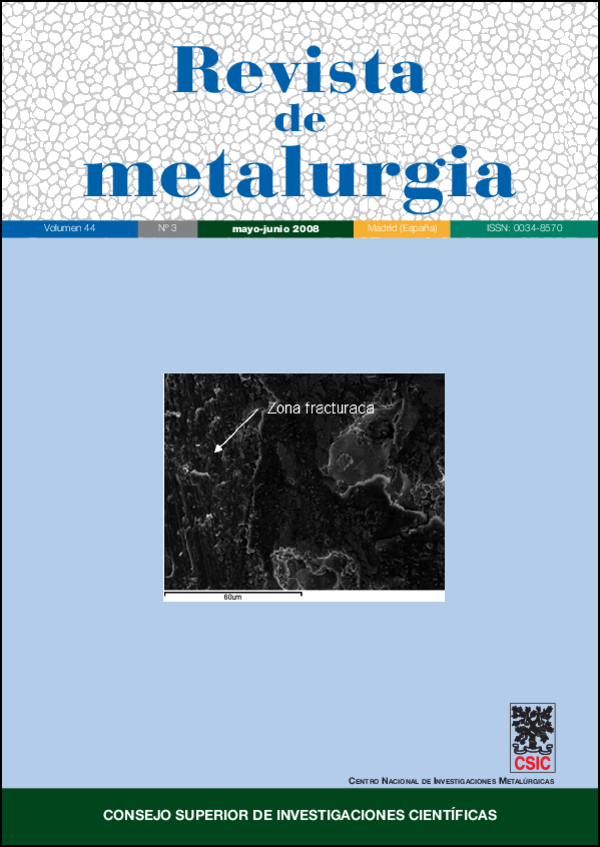Possibility of using by-products of the steelmaking industry for removing lead from aqueous solutions
DOI:
https://doi.org/10.3989/revmetalm.2008.v44.i3.114Keywords:
Rolling mill scale, Blast furnace sludge, Lead, Adsorption, Adsorption isothermsAbstract
A study is made of the use of two steelmaking industry by-products (rolling mill scale and blast furnace sludge) as adsorbent materials for removing Pb2+ ions from aqueous solutions. The adsorption of Pb2+ on these materials has been studied by the determination of adsorption isotherms. Several variables that affect the process (contact time, initial lead ion concentration and temperature) were evaluated. The adsorption processes are analysed using the Langmuir theory. Desorption processes for the metal from loaded by-products were also studied under different experimental conditions. This paper shows that these industrial residues are effective adsorbents for lead ions in aqueous solutions within the range of working concentrations.
Downloads
References
[1] A. Kabata-Pendias and H. Pendias, 2001. Trace elements in soils and plants, CRC Press Inc., Florida.
[2] L. Curkovic, S. Cerjan-Stefanovic and A. Rastovèan-Mioé, Water Res. 35(14) (2001) 3436-3440. doi:10.1016/S0043-1354(01)00037-9
[3] P.D. Johnson, M.A. Watson, J. Brown and I.A. Jefcoat,Waste Manage 2 (2002) 471-480. doi:10.1016/S0956-053X(01)00036-8
[4] F.A. López, M.I. Martín, C. Pérez, A. Lópezdelgado and F.J. Alguacil Water Res. 37 (2003) 3883-3890.
[5] M.I. Martín, F.A. López, C. Pérez, A. Lópezdelgado and F.J. Alguacil, J. Chem. Technol. Biot. 80 (2005) 1223-1229. doi:10.1002/jctb.1305
[6] F.A. López, C. Pérez, E. Sainz and M. Alonso, J. Chem. Technol.Biot. 62 (1995) 200-206. doi:10.1002/jctb.280620214
[7] F.J. Alguacil, Rev. Metal. Madrid 39 (2003) 205-209.
[8] F. Pérez-Moreno, F. Prieto-García, A. Rojas- Hernández, Y. Marmolejo-Santillán, E. Salinas-Rodríguez and F. Patiño-Cardona, Rev. Metal. Madrid 42 (2006) 391-395.
[9] E. Romera, F. González, A. Ballester, M.L. Blázquez and J.A. Muñoz, Rev. Metal. Madrid 43 (2007) 29-41.
[10] F.A. López, F. Medina, J. Medina and M.A. Palacios, Ironmaking Steelmaking 18 (1998) 292-295.
[11] P. Ashodan, M. Saxena and S.R. Asolekar, Resour. Conserv. Recy. 43 (2005) 239-262. doi:10.1016/j.resconrec.2004.06.003
[12] S. Kumar, R. Kumar and A. Bandopadhyay, Resour. Conserv.Recy. 48 (2006) 301-314. doi:10.1016/j.resconrec.2006.03.003
[13] IISI, The Management of Steel Plant Ferruginous By-Products, Committee on Environmental Affairs and Committee on Technology (Eds.), 1994, Brussels.
[14] A. López-Delgado, C. Pérez and F.A. López, Water Res. 32 (1998) 989-996. doi:10.1016/S0043-1354(97)00304-7
[15] M.I. Martín, Tesis Doctoral, Facultad de Ciencias Químicas, Universidad Complutense de Madrid, 2004.
[16] M. Díaz-Peña and A. ROIG-Muntaner, Química Física, vol. 2, Ed. Alhambra Universidad, Madrid, España (1988), pp. 1034-1041.
[17] A. López-Delgado, C. Pérez and F.A. López, Carbon 34 (1996) 423- 426. doi:10.1016/0008-6223(96)87611-1
[18] Federal Register, 1986. Toxicity Characteristics Leaching Procedure (TCLP), 51(216), Friday, November 7, USA, 40643-40654.
[19] Spanish Law 29/1985, 2 August 1985, Real Decreto 849/1986, 11 April 1986, BOE 103, 30 April, 1986. http://www.gestion-ambiental.com/norma/ley/REAL_DECRETO_849-1986.htm.
Downloads
Published
How to Cite
Issue
Section
License
Copyright (c) 2008 Consejo Superior de Investigaciones Científicas (CSIC)

This work is licensed under a Creative Commons Attribution 4.0 International License.
© CSIC. Manuscripts published in both the printed and online versions of this Journal are the property of Consejo Superior de Investigaciones Científicas, and quoting this source is a requirement for any partial or full reproduction.
All contents of this electronic edition, except where otherwise noted, are distributed under a “Creative Commons Attribution 4.0 International” (CC BY 4.0) License. You may read the basic information and the legal text of the license. The indication of the CC BY 4.0 License must be expressly stated in this way when necessary.
Self-archiving in repositories, personal webpages or similar, of any version other than the published by the Editor, is not allowed.
















